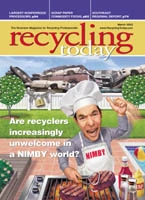Printing plants, large industrial facilities and office buildings may attract the most attention when it comes to procuring commercial scrap paper, but retail stores are not being left behind.
Recyclers have long known that a large percentage of cardboard boxes that produce the old corrugated container (OCC) grade are opened and disposed of at retail stores.
The owners and managers of these retail chains are also well aware that the empty boxes they generate are a desired secondary commodity.
Because of the efforts of recovered fiber dealers looking for material, store owners looking for a return on their OCC and baler manufactures seeking to place machines at generation points, the retail recycling infrastructure has grown.
BOXED IN
Retail locations may generate their share of office paper, but the commodity most commonly associated with grocery, discount and departments stores is OCC.
"We’ve all seen the store personnel stocking the shelves, breaking down the boxes and loading them into a cart or onto a hand pallet to take them to the back room where the baler is," says Joe Szany of Marathon Equipment Co., Vernon, Ala.
Marathon, like many baler companies, has made an effort to offer balers that are ideal for operating in the back room or storage areas of retail stores. As Szany notes, most often these are vertical balers with smaller footprint.
Because OCC is one of the most commonly collected and marketed grades, mills and recyclers have been working to capture the retail stream, even when the price paid for OCC may be slumping.
"Typically, the retail store has a contract with a hauler, paper packer or broker to come by and collect their bales," notes Jim Jagou, a vice president with Harris Waste Management Inc., Peachtree City, Ga.
Jagou says it is increasingly common for recycling companies to send out a flat-bed truck, often with a forklift in tow, to make the rounds of retail locations under contract in a region to pick up bales weekly. "Those bales are then taken back to a central point, consolidated into larger loads and sent to mills," he remarks.
OCC is not handled identically by any means, however. Larger retail sites may have a larger baler, and others may have a compactor on the premises. Smaller stores may only need to manually break down boxes for later collection.
A compactor can retain a lot of material, but does not offer finished processing, notes Szany. "With a compactor, the load is not mill ready. It’s not dense enough to transport over a long distance," he remarks. "The company that installed the compactor might empty it and bring the material back to its facility and then bale it."
VERTICAL BALING
As noted earlier, vertical balers probably have the most widespread presence at retail locations.
"Larger retail generators might use a machine known as a 60/30 HD vertical baler," says Szany, adding that the HD stands for heavy duty and the numbers for bale dimensions that are 60-inches long and 30-inches deep. ("The third dimension is variable, but usually from 40- to 48-inches wide," he adds.)
Jagou concurs that people collecting OCC from retailers "generally prefer a mill-sized bale, 60-inches long that weighs between 1,000 and 1,200 pounds."
A recent Marathon entry in the vertical baling segment is the Stockroom Baler. Szany says it is a small vertical model that does not require any heavy lifting or the use of any lifting equipment. "The baler tips completed bales onto platforms with wheels that come with the baler. These can then be easily moved with a hand cart."
In addition to OCC, many retailers are using their balers to compress the growing amounts of plastic film they see coming through the loading dock. "If you’ve ever seen palletized loads coming in, they stretch wrap most of them. All this film is now in retail back rooms, and it’s becoming a major handling issue."
Jagou notes that many recyclers have agreed to handle the baled film, even though the market is not as established as for OCC.
Both recyclers and baler manufacturers remain interested in the selling or distribution points one step removed from retailing. Ken Korney, director of worldwide sales for International Baler Co., Jacksonville, Fla., notes that distribution centers that handle merchandize before it hits retailers and return centers that handle it afterward are also major generators of the OCC grade.
"At a standard distribution center for a department or discount store, products might come in larger boxes that are emptied out, and the boxes go on a conveyor line to a baler where the OCC is recycled," says Korney. Typically, this baler is a larger, horizontal model.
The volume and pace of generation is quicker than at a retail store, Korney notes. He adds that International Baler recently installed nine horizontal balers at the distribution centers of one national retailer.
| GEARED FOR THE STOCK ROOM |
|
Most baler makers offer smaller, vertical models that are designed to work at retail locations. Marathon Equipment Co., Vernon, Ala., has focused some of its corporate energy on this niche by offering the StockRoom Baler. The StockRoom model stands just six-and-a-half feet tall and slightly less than three feet deep, giving it the sought-after “small footprint.” According to the company’s Web site, Marathon has been successful in placing the models nationwide at one retailer with “hundreds of outlets.” Marathon says the placement of the balers will “help these stores control the high volume of cardboard they generate as well as provide income from recycling the 200 to 400-pound bales.” The StockRoom Baler is described by Marathon as “a self-contained vertical baler that is small enough to fit through a standard door.” The model is also built on casters, making it moveable in storage areas that may sometimes need to be reconfigured. Marathon also provides a small wheeled cart to accompany each baler sold. The wheeled cart can be positioned in front of the baling chamber so that the bale tips automatically onto it. Then, the cart can be rolled to a designated area for later pick-up by the recycling company. |
In addition to the distribution center, most retailers now also operate "return" centers, where returned or unsold merchandise is often backhauled by the same trucks who bring new merchandise to stores.
According to Korney, at these facilities, "the merchandise gets unboxed and scanned and paperwork is done on it before the product goes back to a manufacturer. But the boxes are emptied and placed onto a conveyor, just like at the incoming distribution centers."
Korney says these centers, often run by sub-contractors to the retailers, have become more common in recent years.
NATIONAL REACH
As much as it ever has, retailing is a national industry, with large retail chains now dominating in the department, discount and pharmacy areas. Grocery chains are still largely regional, but usually reach a size of several dozen locations.
Such large companies are increasingly aware of the dollars to be saved (or made) by recycling components of their waste streams rather than disposing of them. "Recycling programs are usually established on the headquarters level for national retailers," says Szany. "Usually they have at least one person whose business it is to know that for "x" number of dollars of merchandise, there is going to be "x" number of tons and dollars of corrugated generated."
Adds Szany, "There is someone in any large chain retailer who is probably very astute in terms of pricing and in setting policies to react to that pricing." He notes reading that an executive from one Carolinas-based grocery chain boasted of fetching $7 million in revenues from the store’s recycling program in one recent year.
"When corrugated is $100 per ton, you can have a lot of balers being purchased because the revenues can justify that," he notes. "But when market prices are low, you might have people charging to remove loads," he continues, making the recycling programs less of an emphasis with many retailers.
The retail chains may purchase their balers and make recycling arrangements nationally or regionally within the chain. "A company that tries to do everything out of its headquarters might work directly with a paper mill company," says Szany. "That mill company will then handle the logistics, often working through its own plants or with regional recyclers."
The end result is a sizable contingent of balers on the job at grocery stores, big box retailers and other store locations throughout North America, generating a steady stream of baled OCC and helping provide a reliable supply of recovered fiber for paper mills throughout the world.
| TARGET: RECYCLABLES |
|
Among the national retailers who have made recycling a corporate priority is Target Corp., Minneapolis, Minn. Jim Bosch of Target was among the panel members who addressed attendees of a 2002 National Recycling Coalition (NRC) Annual Congress session concerning recycling in the commercial sector. Bosch, environmental department director for the retail chain, said that Target began its recycling program by analyzing waste sources and developing programs and measures that each store is expected to follow. The cardboard recycling program is administered nationally, and each store’s participation is tracked. The company also views the redistribution of returned merchandise and even the refurbishing of shopping carts as part of its overall recycling program. The company donates returned and clearance merchandise to non-profit partners such as Goodwill. The non-profit then refurbishes the items for sale in its own stores. Target’s shopping cart program has carts that are no longer deemed acceptable by the store’s standards being refurbished and “de-branded,” Bosch said. The carts are then sold to other retailers. Target recycles carts that are beyond refurbishment with a metals recycler, he noted. |
The author is editor of Recycling Today and can be contacted via e-mail at btaylor@RecyclingToday.com.
Get curated news on YOUR industry.
Enter your email to receive our newsletters.
Explore the March 2003 Issue
Check out more from this issue and find your next story to read.
Latest from Recycling Today
- Altilium produces EV battery cells using recycled materials
- Brightmark enters subsidiaries of Indiana recycling facility into Chapter 11
- Freepoint Eco-Systems receives $50M loan for plastics recycling facility
- PET thermoform recycling the focus of new NAPCOR white paper
- Steel Dynamics cites favorable conditions in Q1
- Hydro starts up construction in Spain
- Green Cubes unveils forklift battery line
- Rebar association points to trade turmoil






